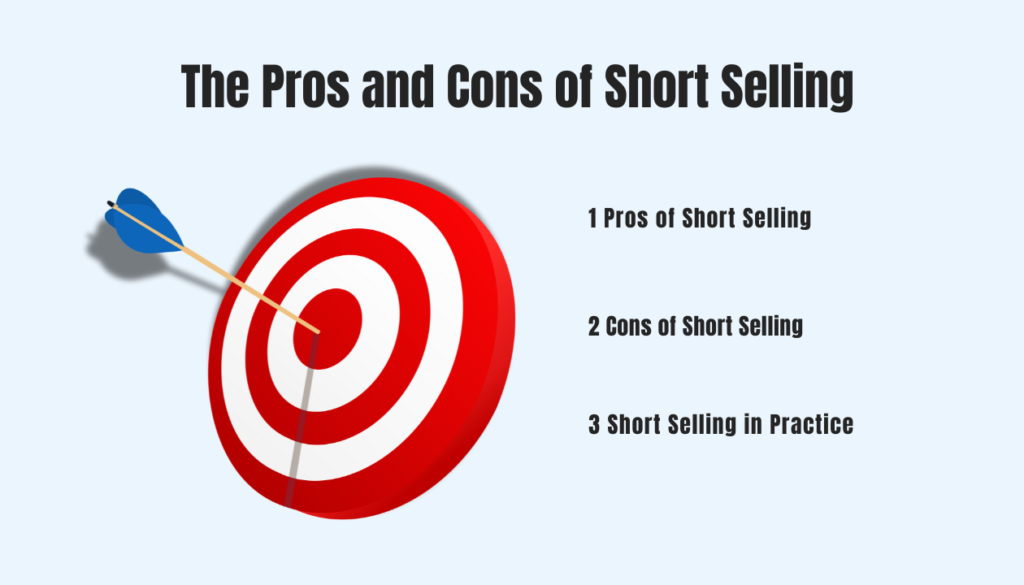Short selling stocks is a trading strategy that involves selling shares you do not own, with the intention of buying them back at a lower price to make a profit. This approach can be highly lucrative but also carries significant risks. Understanding the pros and cons of short selling is essential for traders looking to leverage this strategy effectively. In this blog, we will explore the advantages and disadvantages of short selling stocks, along with key strategies and tips to navigate this complex aspect of stock market trading.
Table of Contents
1. What is Short Selling?
Short selling, or shorting, involves borrowing shares from a broker and selling them on the open market. The goal is to buy back the same number of shares later at a lower price, return them to the broker, and pocket the difference as profit. This strategy is typically used by traders who believe that a particular stock’s price is going to decline.
Advantages of Short Selling Stocks

A. Profit from Declining Markets
One of the main advantages of short selling is the ability to profit from declining stock prices. When markets or specific stocks are trending downward, short selling can be a lucrative strategy.
B. Hedging Against Other Investments
Short selling can act as a hedge against other investments in your portfolio. If you have long positions in certain stocks, shorting related stocks can help offset potential losses in a market downturn.
C. Liquidity and Market Efficiency
Short selling contributes to market liquidity and efficiency by providing more trading volume and price discovery. This helps create a more balanced market where prices reflect true value.
D. Leveraging Market Corrections
Traders can leverage market corrections through short selling. When overvalued stocks experience corrections, short sellers can capitalize on the price decline.
E. Strategic Flexibility
Short selling offers strategic flexibility in various market conditions. It allows traders to take advantage of opportunities in both bullish and bearish markets.
Risks and Disadvantages of Short Selling Stocks

A. Unlimited Loss Potential
Unlike traditional buying where the maximum loss is the amount invested, short selling has unlimited loss potential. If the stock price rises instead of falling, short sellers can incur significant losses.
B. Margin Requirements
Short selling requires a margin account, which involves borrowing from a broker and paying interest. The margin requirements can be high, and a margin call may force you to close positions at an unfavorable time.
C. Market Volatility
Short selling is highly sensitive to market volatility. Sudden positive news or unexpected events can cause stock prices to spike, leading to substantial losses for short sellers.
D. Regulatory Risks
Regulatory changes and restrictions can impact short selling activities. For instance, short selling bans during market crises can affect traders’ ability to execute short positions.
E. Timing Challenges
Successful short selling requires precise timing. Predicting when a stock will decline can be challenging, and mistiming your trades can lead to losses.
Short Selling Strategies

A. Technical Analysis
Use technical analysis to identify potential short selling opportunities. Look for bearish chart patterns, resistance levels, and indicators signaling a downtrend.
B. Fundamental Analysis
Analyze a company’s fundamentals to assess whether its stock is overvalued. Consider financial health, earnings reports, and industry trends to determine if a stock is likely to decline.
C. Market Sentiment
Monitor market sentiment and news that could impact stock prices. Negative news, such as earnings misses or regulatory issues, can create short selling opportunities.
D. Risk Management
Implement robust risk management strategies, such as stop-loss orders and position sizing, to mitigate potential losses. Always have a clear exit strategy in place.
E. Diversification
Diversify your short positions to spread risk across multiple stocks or sectors. This can help reduce the impact of a single stock moving against your expectations.
Conclusion
Short selling stocks is a complex but potentially rewarding trading strategy. While it offers the opportunity to profit from declining markets and provides strategic flexibility, it also comes with significant risks. Traders must thoroughly understand the mechanics of short selling, implement effective risk management practices, and stay informed about market conditions. By weighing the pros and cons and using sound strategies, traders can navigate the challenges of short selling and make informed decisions to enhance their trading success.
Frequently Asked Questions
1. What is short selling, and how does it work?
Ans. Short selling involves borrowing shares from a broker and selling them with the intention of buying them back at a lower price. The goal is to profit from the decline in the stock’s price.
2. What are the risks of short selling stocks?
Ans. Risks include unlimited loss potential, margin requirements, market volatility, regulatory risks, and timing challenges. Short sellers must be prepared for these potential downsides.
3. Can short selling be used as a hedge?
Ans. Yes, short selling can hedge against other investments in your portfolio. It can offset potential losses in long positions during market downturns.
4. How can I identify good short selling opportunities?
Ans. Use technical and fundamental analysis, monitor market sentiment, and stay informed about news that could negatively impact stock prices. Look for overvalued stocks or companies facing challenges.
5. What are the main advantages of short selling?
Ans. Advantages include the ability to profit from declining markets, hedging against other investments, contributing to market liquidity, leveraging market corrections, and strategic flexibility.
